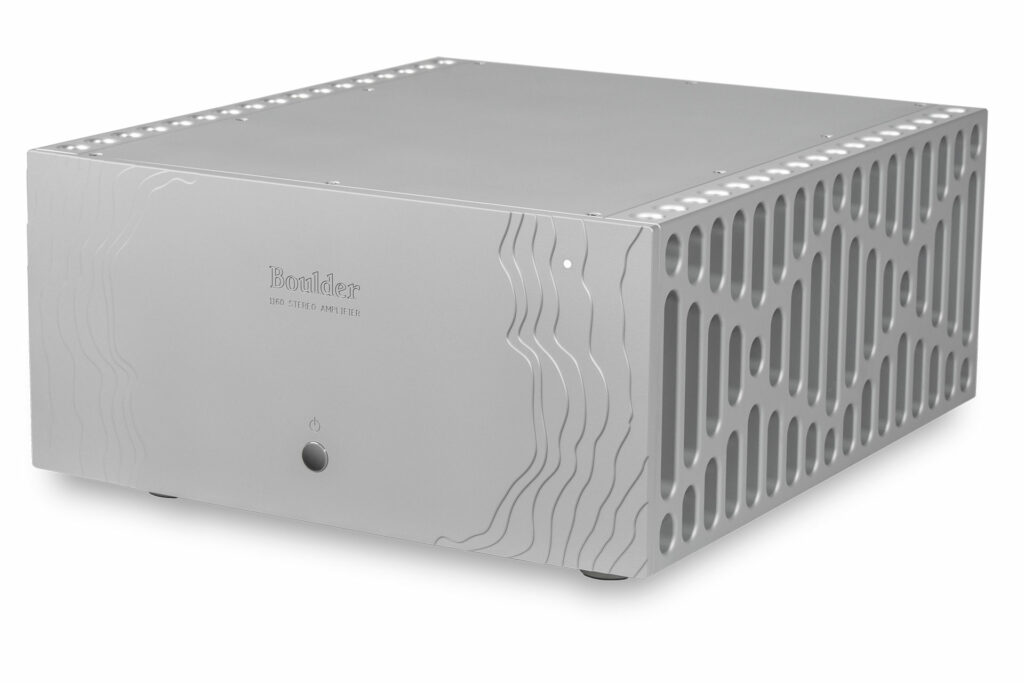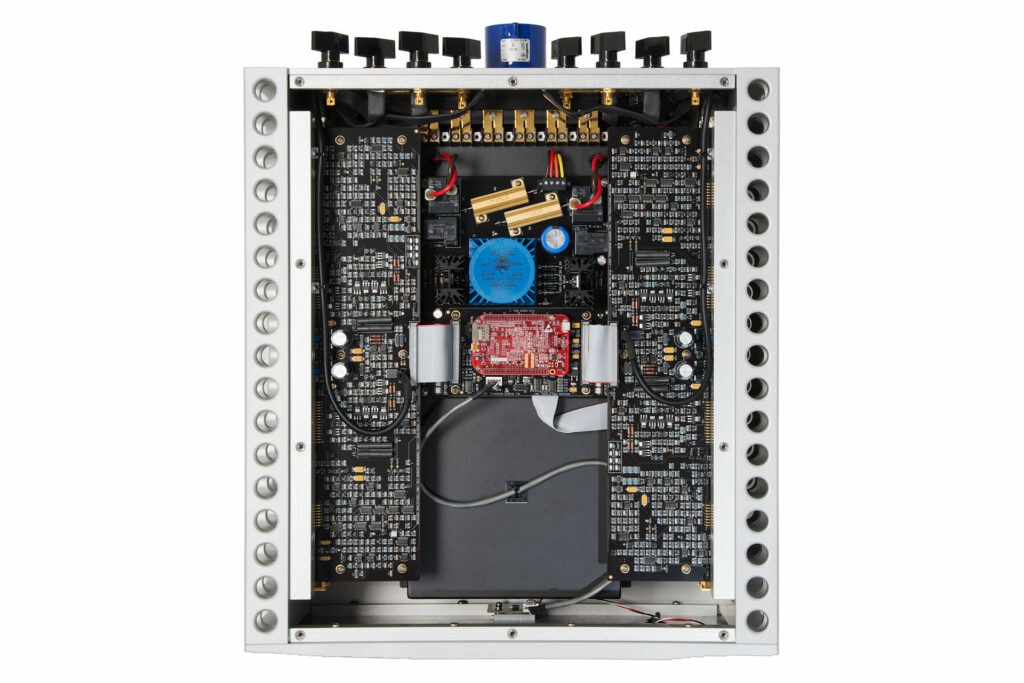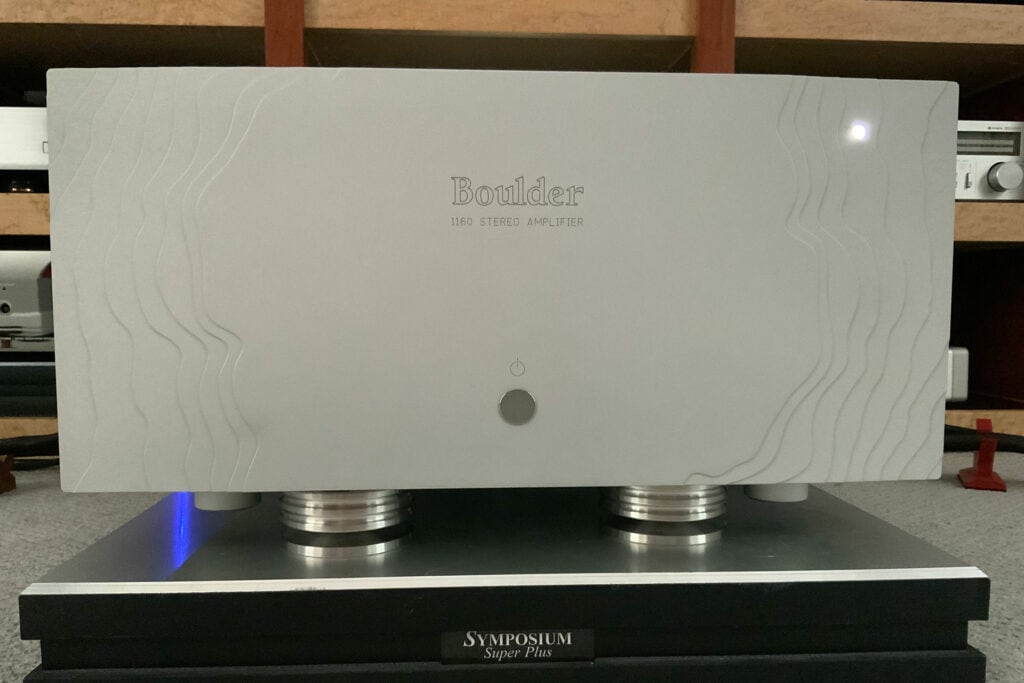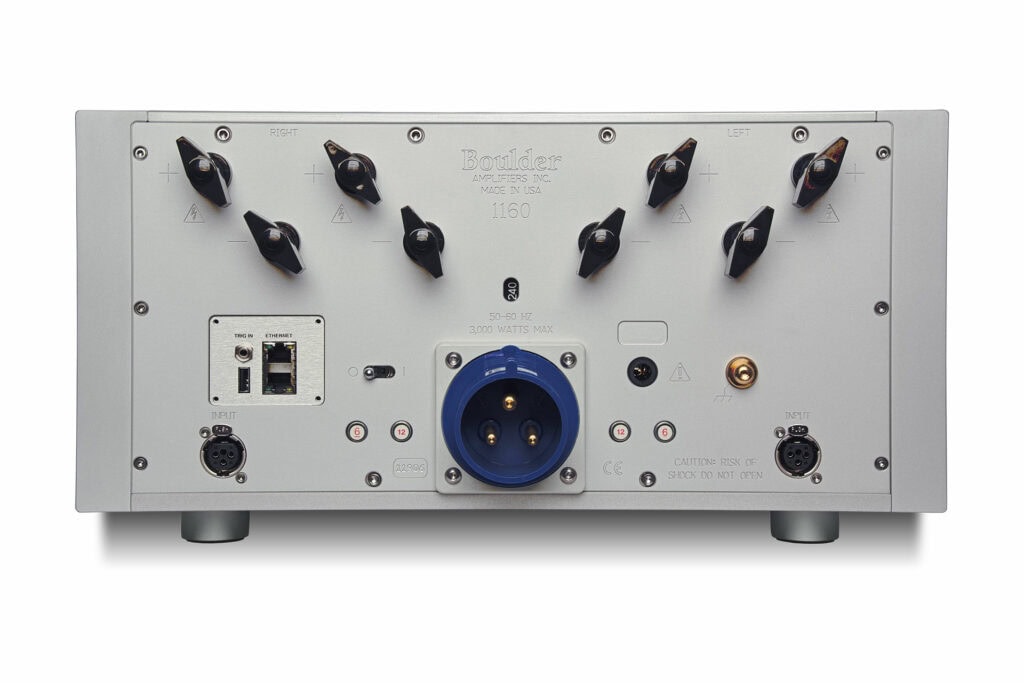Nestled slightly south east of Boulder, Colorado, is a high-end audio company whose name is synonymous with world-class, high-performance gear: Boulder Amplifiers. In fact, Boulder is generally considered by many savvy audiophiles as one of the best overall electronics brands available anywhere at any price.
Positioned in what may be termed the sweet spot of the currently very pricey Boulder lineup is the subject of this review: the Boulder 1160 Stereo Amplifier. As a company, Boulder has a somewhat narrow product offering, as it is predominantly in the amp, preamp, and phono preamp business. While the company does offer two different DACs, and some new products are in development, Boulder chooses to devote their considerable design, engineering, and manufacturing acumen to building some of the elite best amplification components on the planet. Their corporate name says it all: Boulder Amplifiers.

What Makes the Boulder 1160 Stereo Amplifier Special?
- When you invest in a Boulder amp, you get power. Lots and lots of power. Rated at 300 watts per channel of minimum continuous output across 8 Ohms, 4 Ohms, and 2 Ohms, the Boulder 1160 boasts intermittent ratings of 600 watts per channel into 4 Ohms and, should it ever be needed, 1,200 watts per channel into 2 Ohms. While these are the published power ratings, I suspect they are somewhat conservative. After getting the amp installed in my system, the first word I wrote in my review notes was “effortless” to describe what this vast reserve of power sounded like in my room. The Boulder 1160 power amp had no problem at all driving my speakers at any amplitude I desired, and beyond. In fact, I had the distinct impression the amp was sitting there smiling at me because it knew, beyond any doubt, it could run me completely out of the room anytime it wanted. If there is a speaker this amp cannot drive, I would love to hear that speaker and especially the amp powering it.
- The Boulder 1160 is a Class AB amp biased to operate in Class A mode for about the first 17 watts.
- Boulder is one of the most vertically integrated manufacturing companies in all of high-performance audio. Its goal is to design, manufacture, and assemble as many elements in house as is viable. Towards that end, all metal fabrication is done in the Colorado plant on fully automated CNC machining centers. They are then sanded and bead-blasted prior to anodizing (a messy process done outside of the factory). Circuit boards, both surface-mount and through-hole, are built with their own pick-and-place machines complete with advanced wave soldering. All product assembly is then performed, tested, and packaged – again, under one roof. Going to this level of manufacturing excellence gives Boulder a significant amount of control over the components being produced. The end result of this oversight is the ability to build insanely high-quality audiophile gear, with absolute adherence to the design, all intended to offer years of trouble-free enjoyment.
- Boulder pays considerable attention to protective circuits in the 1160. There is circuitry designed to monitor conditions, and if voltages or amperages exceed a predetermined range, the unit will shut down. In addition to voltage and amperage, the Boulder 1160 also employs the use of thermal protection circuits. There are even two circuit breakers per channel on the rear of the cabinet designed to trip and be reset in the event of a fault condition.
- Utilizing a newly designed grounding system, Boulder is dedicated to dual mono, fully differentially balanced circuitry from input to output. These functions serve to reduce distortion, which helps deliver increased sonic clarity and detail.
- In what is quite possibly unique amongst audiophile equipment, Boulder uses a rather large, three pin, 32-Amp IEC electrical connector on the rear of the 1160 amplifier. A nice-quality power cord is included to make AC connections. Their reasoning is simple: this amp has a maximum draw of 3,000 watts and, at max power, draws 25 amps. Boulder did not feel the standard IEC connector could safely and reliably accommodate this amount of current and power draw – should it ever be needed. At no time did I have any issues with AC power during my review of the Boulder 1160, which seems like a result of good design.
- With the use of 56 bipolar output transistors, not the commonly used FETs, the Boulder 1160 Stereo Amplifier is capable of significant power output and the ability to control virtually any speaker.
- Welded steel internal casework ensures both channels and critical components are galvanically separated to help provide a clean, clear output.
- The large heatsinks are all internal, eliminating the possibility of injury to hands when moving, and most importantly, the elimination of any resonances or ringing due to vibrations. Heat is expelled through round holes on each side of the cabinet. I never powered the amp off and it was only ever warm to the touch.
- Based on the more-expensive 2100 class amplifiers, the Boulder 1160 uses a proprietary 983 gain stage. It is designed to operate with very low distortion and noise.
- The large power supply uses twin transformers, one for each channel. These transformers are a toroidal design and serve to ensure separation of noise in each channel. In order to eliminate any possibility of audible hum or vibrations becoming distortion, the Boulder 1160 encapsulates each transformer in a proprietary epoxy resin.
- Two pairs of speaker terminals are rear mounted and only accept spade type cable terminations. Boulder does not believe in banana style plugs and they are therefore not supported. Input connections are XLR for both channels. There are no single-ended type connections on the Boulder 1160.
- Also rear mounted are two ethernet connections, allowing two or more Boulder components to be connected to each other. This makes it possible for a remote or third-party networked controlled devices to operate each component. It is also possible to connect the 1160 to a local network and receive system updates over the Internet.

Why Should You Care About the Boulder 1160 Stereo Amplifier?
Ask even the most dedicated audiophile and they will admit that Boulder amps are expensive. The products are also fabulously designed and painstakingly hand assembled in ways not often seen in this hobby at any price. The Boulder 1160 has power to spare and can drive virtually any speaker system in existence today as well as other, more power-hungry legacy designs. Because a certain amount of its design has been borrowed from Boulder’s more expensive 2000 series of components, and the much more expensive 3000 series of components, the performance of the 1160 relative to its cost makes it a very wise choice for a comparably priced, upper-level audio system.

Some Things You Might Not Like About the Boulder 1160 Stereo Amplifier
- This amp is very heavy. In no way should one person try to move it very far (if at all). I hired a moving company to remove it from the wooden shipping container and carry it upstairs to my audio room. I hired them a second time to get it back downstairs to return to Boulder.
- The proprietary AC power cord means you can’t use your own cord. So if you like to use a specific brand and model of power cord, sorry; only the supplied cord will work (unless a user supplied cord can be re-terminated with an IEC 32 connector).
- RCA interconnects cannot be used – only XLR type connectors. Boulder does manufacturer an adaptor to enable an RCA connector to fit into an XLR connector, though.
- Only spade terminals on speaker cables may be used for speaker connections. Forget banana connectors. Boulder feels fatigue in the banana part of the termination increases over time therefore causing a poor connection and compromised sonics.
Listening to the Boulder 1160 Stereo Amplifier…
Boulder claims not to voice their components, per se, but the 1160 Stereo Amp does seem to have a particular, albeit not super overt, sound. Through countless tracks from four different sources and two preamps, the basics of what I heard was quite similar. For one, abundant power will never be an issue when using a Boulder 1160. This high output means transient detail is fabulously portrayed with the Boulder 1160 in your system. Low level instrumentation may easily be heard and readily identified. Soundstage, imaging, clarity, detail – all are outstanding when compared to amps of comparable value.
Where this amp sets itself apart from other A-listers in the audiophile world is in bass response. Not only are instruments like an electric bass guitar easily identified; the portrayal is fast, clean, and powerful. Individual notes may be followed with ease and there is a certain pop in bass portrayal much more like one would hear in live music. Happily, this low frequency presentation is clean, precise, and distortion free enough to not overpower the lower midrange.
On the Compact Disc release of the all-time audiophile classic Aja by Steely Dan, the track “Peg” has always been a favorite. What I noticed right away, when auditioning the Boulder 1160, was the separation of instruments, particularly between the bass guitar and the drums. And all the while the refined harmonies between the lead singers melded exceptionally well with the multi-tracked backing vocals ably performed by Yacht-Rock god Michael McDonald. I’ve been listening to this song for decades, and every time I hear it, I appreciate it for its simple complexity and the mix of pop, rock, and jazz so craftly woven throughout the track. With the dynamics the Boulder 1160 was easily able to create, this longtime favorite sounded simply glorious.
Originally released in 2003, “Breathe” from the Hotel Paper release by Michelle Branch is, from start to finish, a song with very little dynamic range. What begins with a mostly aggressive acoustic guitar quickly turns into a hybrid pop/rock-based tune. The midrange is excellent and despite the tight, precise bass line, the guitar is never overshadowed. Chalk this up the Boulder 1160’s ability to cleanly and clearly portray detail, regardless of frequency or amplitude. Most interesting was how the mix was layered to become bolder and more complex.
Does the Boulder 1160 Stereo Amplifier Have Any Resale Value?
As a company, Boulder designs its equipment for decades of trouble-free usage. In fact, in standby mode, Boulder even states the unit may be left powered on for years with no damage. And about the only time the company releases a new model is when significant advancements in design yield something truly special. As such, any existing Boulder component tends to remain active for quite a long time and not be replaced by a new version in a year or so. Likewise, Boulder equipment is not found very often on the used market. I did find a few selections of mostly 2000- and 3000-series equipment. Based on the asking price, used values were slightly north of a 50 percent discount from list. This suggests the resale value, when it exists at all, is excellent.

What Other Amps Compete With the Boulder 1160?
There are more contenders than one might imagine in this price class. One brand normally receiving a lot of attention is Switzerland based CH Precision. Probably the closest amp product in price is the CH Precision A1.5, which begins at about $40,000 and, given the various options, the final price may rise to more than double that figure. The A1.5 is rated at 150 watts per channel into 8 Ohms, and 275 WPC into 4 Ohms. It features a variable input gain and a user-selectable global feedback. It may also be operated in bridged mode, which the Boulder 1160 cannot. Bridged mode on a stereo amp intended to replicate monoblocks may be viewed positively by some and negatively by others. Like Boulder, CH Precision has several models and upgrades, with costs into the hundreds of thousands of dollars.
Another sexy Swiss audiophile brand is Solution, and its Series 5 level of components seems to match with Boulder’s 1100 series. The Solution 511 retails for $39,975 and is physically quite large, so, like the Boulder 1160, it may be difficult to rack mount. It features 140 WPC into 8 Ohms and 280 WPC into 4 Ohms. This amp is a Class A design, not Class AB, so heat may be an issue. Solution uses a somewhat unique 10 power supplies, with each one optimized for a particular function. It is claimed this configuration delivers stable power with high speed and low noise.
I was very excited to compare the Boulder 1160 to my reference T+A A3000HV. Both are meticulously engineered, extremely well made, and powerful amplifiers. Both are rated at a minimum of 300 WPC into 8 Ohms. The T+A A3000 HV (read the review) is designed with high-voltage rail technology, meaning the rail voltage is much higher than the typical Class AB solid state amp. Because high voltage rail technology approximates a tube amp, it is claimed it delivers a warmer, more enjoyable sound.
In a direct comparison, both were very powerful amps, although I feel the Boulder had marginally more to give than the A3000. Both had excellent imaging, although the T+A was slightly wider in lateral side-to-side comparisons. However, the Boulder 1160 presented a taller bottom-to-top image. Image depth was equivalent. Both were equally detailed and accurate. The T+A was marginally more aggressive in the midrange and upper frequencies where the Boulder 1160 was somewhat more laid back. Overall, however, the Boulder 1160 was slightly more dynamic. Where the Boulder 1160 excelled was in bass response. I have never heard better, more controlled, more believable bass on my system, in my listening room, than I did with the 1160 amp. It is also worth noting the T+A A3000HV retails for $24,500, so price becomes a factor in the decision-making process.
Final Thoughts on the Boulder 1160 Stereo Amplifier
It was a real joy to have the Boulder 1160 Stereo Amplifier (and the 1110 preamplifier – review to follow) in my system. This is an amp with such a ferocious amount of power, it somehow gives a feeling of invincibility. What I was happy to realize was, in addition to power, the 1160 also delivered the finesse, level of fine detail, and musical enjoyment one might expect from a world-class component. It is obvious considerable engineering and manufacturing excellence goes into the production of this amp. Boulder is a company that absolutely does not cut corners. Everyone at the company is unapologetically committed to excellence. The goal is to offer a component capable of remaining relevant and producing world-class sonics for years, while staying on the cutting edge of technology.
While I had the 1160 amp in my system, I kept thinking about what might possibly be in store if I had the series 2000, or the even more outrageous, series 3000 amp. I had to keep reminding myself this amp was the third best from the top, so, as exceptional as it sounds, there are conceivably two Boulder products even better.
This is obviously not an amplifier for the masses or even most advanced audiophiles because of its staggeringly high price. For those systems of commensurate value and capability, the Boulder 1160 Stereo Amplifier has the very real ability to be a game-changing piece of audiophile equipment. Power, performance, stunningly good looks, and excellent sonics make the Boulder 1160 Stereo Amplifier a remarkable product and one worth serious investigation for those with the interest and means to make such a meaningful investment in their music playback system.


All I can say is WOW,
Boulder is the definition of WOW.
I love that they are coming out with $8000 components now. Still expensive in my book but not BAT-SHIT CRAZY expensive that I couldn’t dream of owning. I want the amp and preamp for review soon. 🙂
Great Article. Well written, comprehensive, and it’s nice and rare to walk away with practical insight into the product being reviewed. Really like that you made real-world comparisons and articulated where the Boulder amp excelled and where another product might have had the edge. All to often I read reviews where everything is perfect and the product being reviewed is the best in the world… Also, looking forward to the 1110 preamp review.
One correction. I believe the Swiss brand is Soulution and not Solution. Assuming your auto-correct took over.
Thank you for your kind words.
Yeah Frank, it’s probably auto correct! We both know I’m perfect, right!!!
I’m glad you enjoyed the review.
I can tell you having this amp and preamp in my system was really nice. I hated to send it back.
I bet you did! I would too. Keep up the great work.
Oh, yeah Frank, thanks for your kind words!!!!
Much appreciated!
It bugs me that Boulder places the power LED on the side of the amp instead of centered. Why would they do anything so insane?
It aint going to keep their stuff out of my rack.
Might I say after a factory tour in September, Boulder has the best metal work of any high end brand. Vinnie Rossi too.
Aside from the corrosion on the right side you may be right.
I’m just guessing here, but it may have something to do with where the wires are located and convenience of making connections inside the cabinet. I can also say it is a very small light and in the brightness of daytime, not easily seen. Having it in the center, on a bright sunny day, would probably not make it any more visible in the center or anywhere on the front of the cabinet. In even a slightly darkened room, even closing the shades in the daytime, the light is easily visible.